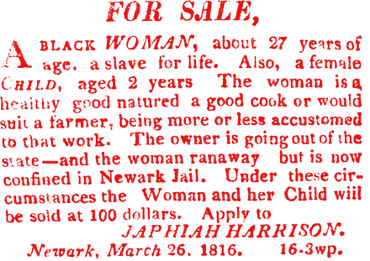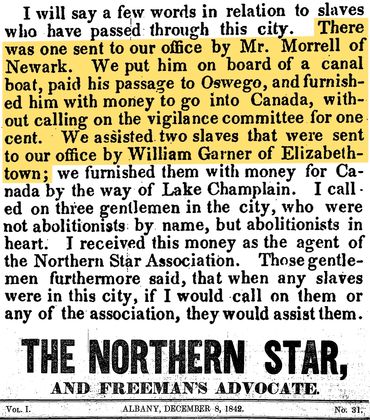
Noelle Lorraine Williams | Researcher, Artist and Curator
Newark's Underground Railroad
Newark was honored by the National Underground Railroad Network to Freedom with recognition of the former Plane Street Colored Church (renamed as the Frederick Douglass Field).
"As an anti-slavery man, Mr. Morel has a record, and many self-emancipated souls now in Canada and elsewhere, will long remember the aid they received from Mr. Morel, while they were passing over the 'Underground Railroad.'" - Eulogy of Junius Morel who taught school at Plane street colored church
America's Earliest Civil Rights Movement



.jpg/:/cr=t:0%25,l:0%25,w:100%25,h:100%25/rs=w:370,cg:true)


Welcome
Newark's Black Liberation Heritage
Plane Street Colored Church
Frederick Douglass Field
“Slavery is the next thing to hell.”
— Harriet Tubman (1855)
Welcome to this exhibition!
In 1998, United States Congress acknowledged that “The Underground Railroad, which flourished from the end of the 18th century to the end of the Civil War, was one of the most significant expressions of the American civil rights movement during its evolution over more than three centuries.” Those expressions of freedom happened in Newark, too.
The Plane Street Colored Church was built in 1836 and was located on the current Frederick Douglass Field at Rutgers University in Newark, New Jersey. The church represents the unyielding work of the Newark Black activist community for Black emancipation and as Underground Railroad activists.
It exemplified the ways in which free northern Black people helped build the UGRR for freedom seekers as stationmasters, activists, lecturers and artists, with a national network of Black activists. The church was also a school, meeting hall and lecture hall. The Colored Anti -Slavery Society of Newark and the Relief Society, a group that assisted freedom seekers with funds and resources was affiliated with it. It was also the direct connection to an UGRR station operated by the treasurer of the Relief Society, Jacob King, and his home/station only a few feet away. Freedom seekers and the formerly enslaved ministered, taught at the school located there, and worshipped at this church. The church’s leadership included many prominent persons connected to the UGRR, including freedom seekers and operatives Samuel Eli Cornish, Junius Morel, Samuel Ringgold Ward, Christopher Rush, and poet Elymas Payson Rogers, writer of the nationally performed "A Poem on the Fugitive Slave Law."
- Noelle Lorraine Williams, Curator and Researcher, Black Revolutionary Writers Fighting Colonialism: Queen Latifah, Samuel Cornish and Amina & Amiri Baraka
INTERNATIONAL UNDERGROUND RAILROAD MONTH 2024
invisible black city: Newark Underground Railroad Walking tour - October 26, 2024 2PM
Register on the Events page.

Video
Our Partners

Black Power! 19th Century
Copyright © 2025 Black Power! 19th Century - All Rights Reserved.

Exhibition Newark Museum of Art Ballantine House Reopens!
Welcome! Stay! The Black Women of Nineteenth Century Newark is currently open. Also, check out online exhibition and maps!